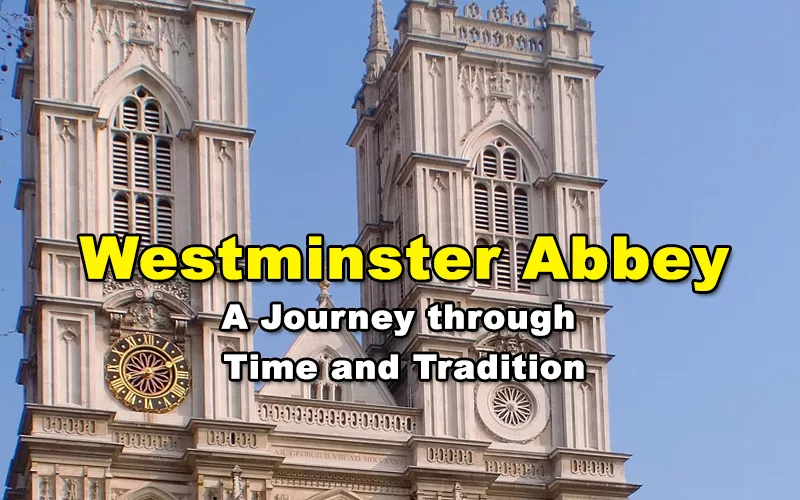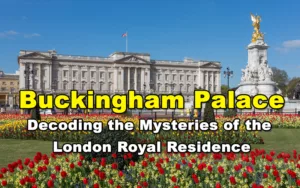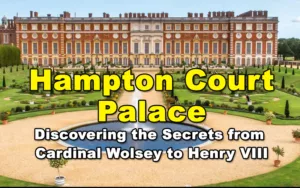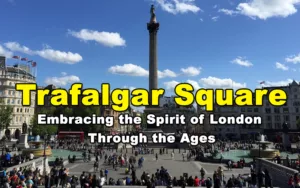Westminster Abbey, an architectural masterpiece and historical sanctuary, sits gracefully in the bustling center of London in the City of Westminster. With its roots stretching back to the 10th century, this Gothic wonder has been a silent observer to numerous transformative moments and expansions that have shaped its structure and significance over time. Today, it wears many hats – it is a sacred place of worship, a final resting place for Britain’s illustrious sons and daughters, and a treasure trove of history that draws in millions from across the world. Each stone and stained glass window tells a story, making the Abbey not just a sight to behold but a living, breathing chronicle of British heritage and culture.
Westminster Abbey’s imprint on British history is profound and enduring. As the coronation church since 1066, it has played a central role in the country’s monarchical tradition, hosting the crowning ceremonies of English and later British monarchs. The Abbey has also been the backdrop for a plethora of royal events, including majestic weddings and solemn funerals, cementing its place as an indispensable part of the nation’s cultural fabric. But its significance doesn’t end there; Westminster Abbey has also been a hub for intellectual and artistic enlightenment, providing a final resting place for some of the UK’s most revered authors, scientists, and leaders.
This article seeks to unravel the intricate tapestry of history, art, and culture that Westminster Abbey represents. By delving deep into its architectural beauty, pivotal historical moments, religious relevance, and contributions to culture, we aim to offer readers a thorough understanding of the Abbey’s extensive role in British society. The intention is to shed light on the Abbey’s timeless legacy, its influence on the country’s heritage, and underscore the imperative of preserving this grand structure for the enjoyment and education of future generations. Whether you’re a history buff, a lover of architecture, or someone who cherishes the cultural treasures of Britain, this article aspires to enrich your knowledge and deepen your appreciation for the splendid Westminster Abbey.
The Architectural Grandeur of Westminster Abbey
Evolution of Architectural Styles
Original Construction and Early Styles: Westminster Abbey’s journey through architectural history begins in the 10th century, when a community of Benedictine monks established a monastery at this site. The original structure, long since replaced, bore the hallmarks of early medieval architecture. The Abbey we recognize today started taking shape under King Edward the Confessor in the mid-11th century, incorporating Romanesque features prevalent in Norman architecture. The imposing presence of rounded arches and robust stone construction characterized this period.
Gothic Influences and Transformations: The Abbey underwent transformative changes in the 13th century during the reign of King Henry III. Inspired by the grand cathedrals of France, Henry III initiated an ambitious reconstruction project, ushering in the English Gothic architectural style. Pointed arches, ribbed vaults, and flying buttresses became defining features, facilitating the construction of taller, more light-filled spaces. The introduction of the Gothic style also saw the addition of intricate stone carvings, elaborate window tracery, and a focus on verticality that has come to define the Abbey’s aesthetic.
Modern Restorations and Conservation Efforts: Over the centuries, Westminster Abbey has undergone numerous restoration and conservation efforts, ensuring its survival and relevance in the modern era. Victorian-era restorations, led by architects such as Sir George Gilbert Scott, aimed to preserve the integrity of the Gothic structure while implementing necessary repairs. In recent decades, ongoing conservation work has focused on preserving the Abbey’s artistic and architectural heritage, addressing the challenges of pollution, weathering, and the passage of time.
Key Architectural Features
The Nave: The Abbey’s nave stands as one of the most impressive Gothic spaces in England, with its towering vaults, intricate stone work, and expansive length creating a sense of awe and grandeur. This central aisle plays a crucial role in royal processions, providing a dramatic backdrop to coronations and other ceremonial events.
The Transepts: The North and South Transepts contribute to the Abbey’s cruciform layout, housing chapels, monuments, and memorials. These transverse aisles not only provide structural support for the towering nave and choir but also enhance the Abbey’s spatial complexity and artistic richness.
The Quire and Altar: Found at the core of Westminster Abbey, just beyond the sweeping expanse of the nave, lies the Quire and Altar—a space steeped in religious significance and adorned with meticulous artistry. This area is distinguished by its intricate woodwork, lavish carvings, and an ambiance of sacred intimacy, all of which work in harmony to create a profound spiritual experience. The grandeur that defines the nave gives way to a more personal and contemplative atmosphere here, inviting visitors and worshippers alike to engage in moments of reflection and prayer.
The Cloisters: Providing a serene escape from the bustling activity of the main church, the Cloisters are nestled to the south of Westminster Abbey, offering a space of quiet reflection and meditation. This enclosed walkway, with its arched openings and view of a peaceful central courtyard, forms a unique connection between different parts of the Abbey. As you stroll through the Cloisters, you can’t help but feel transported back in time, enveloped in the tranquility of this space and reminded of the Abbey’s rich monastic history.
The Towers and Western Façade: The Abbey’s two towering western spires, completed in the 18th century, add a sense of symmetry and grandeur to the overall structure. The intricate Gothic detailing of the Western Façade, including the Great West Door, serves as a stunning entryway, capturing the essence of the Abbey’s architectural majesty.
Artistic Embellishments
Stained Glass Windows: The Abbey’s stained glass windows are masterpieces of color and light, with designs ranging from medieval to modern. These windows not only enhance the spiritual atmosphere of the space but also serve as important artistic and historical artifacts.
Sculptures and Monuments: Westminster Abbey is home to a vast array of sculptures, statues, and monuments, celebrating the lives of Britain’s monarchs, heroes, and notable figures. These artistic works contribute to the Abbey’s status as a “Royal Peculiar” and a space of national significance.
Ornate Tombs: The elaborate tombs of kings, queens, and aristocrats reflect the Abbey’s role as a burial place for the British elite. Intricate carvings, precious materials, and artistic craftsmanship characterize these memorial structures, adding to the Abbey’s rich tapestry of art and history.
The Historical Significance of Westminster Abbey
The Abbey as a Royal Peculiar
Westminster Abbey is bestowed with a distinctive honor within the Church of England, being recognized as a “Royal Peculiar.” This unique status means that the Abbey operates directly under the monarch’s jurisdiction, bypassing ecclesiastical oversight from bishops or archbishops. This designation is a testament to the Abbey’s profound connection with the British royal family and underscores its pivotal role in the country’s religious and ceremonial life. The Abbey’s status as a Royal Peculiar was established in the medieval period, highlighting its long-standing importance not just as a place of worship, but also as an institution integral to the United Kingdom’s history and traditions.
Coronations and Royal Ceremonies
Historical Overview of Royal Coronations: Westminster Abbey has held the esteemed position of being the chosen venue for the coronation of English and later British monarchs since William the Conqueror’s ceremony in 1066. These events are pivotal moments of national unity and joy, with the Abbey providing a majestic backdrop for the celebrations. The Coronation Chair, residing within the Abbey for over seven centuries, serves as a historical artifact, connecting present-day ceremonies with the deep roots of the nation’s past.
Significance in the British Monarchy: The Abbey’s role in hosting coronations goes beyond ceremonial pomp; it is woven into the very fabric of the British monarchy, both constitutionally and ceremonially. Its involvement in these grand events cements its status as a symbol of the country’s continuity, traditions, and national identity, playing a crucial role in maintaining and celebrating Britain’s royal heritage.
Burials and Memorials
Kings, Queens, and Noble Figures: Over 3,300 individuals have found their final resting place within the hallowed walls of Westminster Abbey, including 30 monarchs and a multitude of noble figures. The site serves as a historical archive, with its tombs and memorials telling the tales of Britain’s political and social evolution, paying tribute to those who have played pivotal roles in shaping the nation.
Writers, Scientists, and Notable Personalities: The Abbey’s commemorative role extends beyond royalty, embracing writers, scientists, and other luminaries who have left indelible marks on British history. The presence of giants such as Isaac Newton, Charles Darwin, and Geoffrey Chaucer within its precincts highlights the Abbey’s commitment to honouring the intellectual and cultural contributions that have defined the nation.
The Poets’ Corner: Nestled in the South Transept, the Poets’ Corner stands as one of Westminster Abbey’s most cherished and frequented sections, dedicated solely to celebrating Britain’s literary legends. This space, enriched by memorials and the graves of literary titans like William Shakespeare, Jane Austen, and Charles Dickens, serves as a physical ode to the nation’s storied literary tradition. Through its preservation of these memories, the Abbey solidifies its role as a custodian of British cultural and historical legacy.
The Religious and Cultural Role of Westminster Abbey
The Abbey as a Place of Worship
More than a monumental relic of the past, Westminster Abbey stands vibrantly as a sanctified place of worship, actively serving its religious community and welcoming visitors from all corners of the globe. The Abbey is alive with the sounds of daily services, echoing traditions held dear by the Church of England, and offering solace and spiritual guidance to all who seek it. From the clergy to the choir, and the extensive staff in between, there is a dedicated team ensuring the religious heartbeat of the Abbey remains strong, making it a sanctuary for reflection, prayer, and reverence.
The Abbey’s Role in the Anglican Communion
As an esteemed Royal Peculiar and a towering figure among the churches of the United Kingdom, Westminster Abbey occupies a revered place within the Anglican Communion. It stands as a testament to the enduring legacy and rich heritage of Anglicanism, with its clergy actively participating in the national religious landscape. The Abbey frequently plays host to significant ecclesiastical events and services, bolstering its standing as a pivotal institution within the Anglican tradition.
Cultural Events and Public Engagement
Concerts and Performances: Westminster Abbey stands as much more than just a visual marvel; it is a vibrant center of outstanding musical talent, housing a highly esteemed choir and a magnificent organ that fills the space with harmonious sounds. All year round, the Abbey becomes a stage for an array of concerts and performances, celebrating its deep-rooted musical history and providing audiences with the unique opportunity to immerse themselves in the performing arts in an environment that is nothing short of breathtaking. These gatherings do more than just uphold the Abbey’s longstanding musical traditions; they also create a bridge, connecting the community with the arts and ensuring that these rich cultural practices continue to thrive and resonate with people from all walks of life.
Educational Programs and Tours: Acknowledging its role as an educator and cultural beacon, Westminster Abbey extends a variety of educational initiatives and guided tours to the public. Aimed at deepening the understanding of the Abbey’s historical, architectural, and religious dimensions, these programs cater to a diverse audience, ranging from young students to adult learners. The Abbey’s approach to education is interactive and immersive, featuring workshops, lectures, and tours that breathe life into its storied past. These endeavors emphasize the Abbey’s dedication to community engagement and cultural enlightenment, securing its position as a fountain of knowledge and history in the bustling heart of London.
Visiting Westminster Abbey
Visiting Westminster Abbey is akin to stepping into a living, breathing page of history, with its stunning architecture and rich tapestry of historical events. Here’s how to make the most of your visit:
Planning Your Visit
Opening Hours and Admission Fees: Understanding the Abbey’s opening hours is crucial, as they can vary due to special events and religious services. Generally, it welcomes visitors from Monday to Saturday, with shorter visiting hours on Wednesdays. While tourists need to pay an admission fee, entry is complimentary for those attending religious services. It’s advisable to purchase your tickets online beforehand to bypass the long queues, ensuring a smoother entry. Additionally, discounts are available for students, seniors, and families, making the experience more affordable.
Guided Tours and Audio Guides: The Abbey offers both guided tours led by well-informed guides and audio guides available in various languages. These tools provide a rich narrative of the Abbey’s storied history, intricate architecture, and the notable personalities interred within its walls. Leveraging these resources can significantly enhance your experience, immersing you in the stories and intricacies that you might have otherwise overlooked.
Highlights and Must-See Areas
Westminster Abbey is a treasure trove of history and artistry. Key highlights include:
The Coronation Chair: A silent witness to the coronation of every English monarch since the 1300s.
The Poets’ Corner: A sanctuary for literature, housing the final resting places of numerous literary greats.
The Royal Tombs: Home to the eternal resting places of Queen Elizabeth I and Mary, Queen of Scots, among others.
The Lady Chapel: A marvel of medieval architecture, featuring an exquisite fan-vaulted ceiling.
The Cloisters: A serene space, offering a moment of calm and a window into the Abbey’s monastic history.
Tips for an Enriching Experience
Allocate Ample Time: The Abbey is brimming with history, art, and spirituality. Ensure you give yourself enough time to fully absorb its magnificence.
Observe the Guidelines: Remember, this is a sacred space. Adhere to any rules regarding silence, photography, and respectful behavior.
Experience a Service: If possible, attend an Evensong or another service for a unique and spiritually uplifting experience.
Explore the Vicinity: The Abbey’s surroundings are steeped in history, with landmarks like the Houses of Parliament and Big Ben nearby. Ensure you explore these areas to round out your visit.
Check for Special Events: The Abbey hosts various events and exhibitions year-round. Visit the official website to see if there are any special happenings during your visit.
By planning ahead, respecting the Abbey’s sacred atmosphere, and fully immersing yourself in its historical and artistic offerings, your visit to Westminster Abbey can be an unforgettable journey through time.
The Future of Westminster Abbey
Ongoing Conservation and Restoration Efforts
Westminster Abbey stands as a testament to centuries of history, and safeguarding this legacy demands unwavering dedication and care. The Abbey’s custodians are staunchly committed to a continuous cycle of conservation and restoration work, ensuring that this awe-inspiring structure can be enjoyed by future generations. The challenges are manifold, ranging from natural aging and pollution damage to the sheer wear and tear resulting from its popularity as a tourist destination. A dedicated team of conservators, historians, and architects meticulously tend to the Abbey’s fabric, its myriad artworks, and the numerous monuments it houses. They strive to strike a delicate balance, preserving the Abbey’s rich heritage while accommodating its ongoing role as a dynamic place of worship.
The Abbey’s Role in Contemporary Society
In a world that is constantly evolving, Westminster Abbey steadfastly maintains its significance in both national and religious spheres. The Abbey is the backdrop to state occasions, memorials, and celebratory events, continuing to be a place where history is made. Beyond these grand occasions, it also embraces a role as a space for contemplation and dialogue on pressing contemporary issues, contributing meaningfully to conversations about morality, ethics, and the place of faith in today’s world. Through a diverse array of services, events, and public engagements, the Abbey cultivates a sense of community and a connection to our shared heritage, ensuring its continued relevance and influence in the modern era.
Engaging New Generations: The Road Ahead
Ensuring that Westminster Abbey remains a vibrant and relevant part of society means reaching out to and captivating the younger generations. It’s about kindling their curiosity and respect for the rich tapestry of stories, values, and traditions that the Abbey represents. Westminster Abbey is actively innovating, embracing modern storytelling techniques, digital engagement, and educational initiatives to broaden its appeal and deepen the connection people feel towards its legacy. It stands as a crucial mentor, urging the youth to explore their heritage, understand the significant role played by institutions like itself, and recognize their own part in the ongoing story of our national identity. As we look ahead, Westminster Abbey is fully prepared to carry its legacy forward, intertwining faith, heritage, and community, and building a robust foundation for the many generations that will follow.
Summing Up Westminster Abbey
The Enduring Legacy of Westminster Abbey
Westminster Abbey stands as a monumental testament to the rich tapestry of British history, its architectural brilliance, and its profound cultural significance. For numerous centuries, it has occupied a central role in the nation’s religious and ceremonial narratives, hosting the coronations of monarchs, commemorating the lives of saints and literary giants, and offering solace and inspiration to countless souls. Its distinguished status as a Royal Peculiar, combined with a treasure trove of artistic masterpieces and its role as the final resting place for some of the nation’s most eminent figures, culminate to forge its unparalleled legacy.
The Abbey’s ability to withstand the test of time underscores its deep-seated importance and the unwavering dedication of those tasked with its care. From its foundational years in the 10th century to its prominent place in the 21st, Westminster Abbey has demonstrated a remarkable ability to evolve, adapt, and persevere, remaining a steadfast beacon in an ever-changing world. It embodies the soul of a nation, standing tall as a symbol of faith, tradition, and extraordinary cultural achievement.
Encouraging Appreciation and Preservation
In pondering the grandeur and historical importance of Westminster Abbey, we find ourselves entrusted with the responsibility to cultivate a profound appreciation for this architectural marvel. Engaging the public, inspiring new generations, and championing the cause of ongoing conservation and restoration are critical endeavors to ensure that the Abbey’s splendor is preserved for the enjoyment and reflection of future generations. By fostering collective awareness and committing to protect this iconic edifice, we play our part in the perpetuation of its rich legacy.
Westminster Abbey is so much more than a mere structure; it is a vibrant chronicle of history, a sacred space for worship, and a dynamic cultural hub. In valuing its past, celebrating its ongoing story, and investing in its sustainable future, we help to secure its place as an invaluable jewel in the crown of Britain’s national heritage, standing as an enduring symbol of resilience, grace, and profound significance.
“I may earn commissions as an affiliate from sponsored links within this post”








